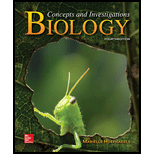
Concept explainers
A prokaryotic cell is one that
- a. lacks DNA.
- b. has membrane-bounded organelles.
- c. lacks a nucleus.
- d. lacks a plasma membrane.
Introduction:
A prokaryotic cell is a primitive cell with unbound organelles and genetic material. It makes up the two of the three domains which are Bacteria and Archaea. They have less organelles and lesser specializations.
Answer to Problem 1MCQ
Correct answer:
A prokaryotic cell lacks the nucleus. Therefore, option c. is correct.
Explanation of Solution
Reason for the correct statement:
The prokaryotes have a single DNA strand, lacking histones and even a membrane. The DNA is just present in the cytoplasm like other organelles. It is called a nucleoid. The proper double membrane bound nucleus found in eukaryotes is missing in prokaryotes.
Option c. is given as “lacks a nucleus”.
As, “a prokaryotic cell is one that lacks a nucleus”, is the right answer.
Hence, the option c. is correct.
Reasons for the incorrect statements:
Option a. is given as “lacks DNA”.
DNA is the carrier of all the hereditary information. It is present in all the organisms. So, it is a wrong answer.
Option b. is given as “has membrane-bounded organelles”.
A prokaryotic cell does not have any membrane bound organelles. So, it is a wrong answer.
Option d. is given as “lacks a plasma membrane”.
Plasma membrane encloses the cytoplasm of a cell. It is present in all the cells. So, it is a wrong answer.
Hence, options a., b. and d. are incorrect.
One very distinctive feature between eukaryotes and prokaryotes is the presence and absence of nucleus, respectively.
Want to see more full solutions like this?
Chapter 17 Solutions
Biology: Concepts and Investigations
Additional Science Textbook Solutions
Physics of Everyday Phenomena
Microbiology Fundamentals: A Clinical Approach
Human Physiology: An Integrated Approach (8th Edition)
Genetics: From Genes to Genomes
Chemistry: An Introduction to General, Organic, and Biological Chemistry (13th Edition)
- In one paragraph show how atoms and they're structure are related to the structure of dna and proteins. Talk about what atoms are. what they're made of, why chemical bonding is important to DNA?arrow_forwardWhat are the structure and properties of atoms and chemical bonds (especially how they relate to DNA and proteins).arrow_forwardThe Sentinel Cell: Nature’s Answer to Cancer?arrow_forward
- Molecular Biology Question You are working to characterize a novel protein in mice. Analysis shows that high levels of the primary transcript that codes for this protein are found in tissue from the brain, muscle, liver, and pancreas. However, an antibody that recognizes the C-terminal portion of the protein indicates that the protein is present in brain, muscle, and liver, but not in the pancreas. What is the most likely explanation for this result?arrow_forwardMolecular Biology Explain/discuss how “slow stop” and “quick/fast stop” mutants wereused to identify different protein involved in DNA replication in E. coli.arrow_forwardMolecular Biology Question A gene that codes for a protein was removed from a eukaryotic cell and inserted into a prokaryotic cell. Although the gene was successfully transcribed and translated, it produced a different protein than it produced in the eukaryotic cell. What is the most likely explanation?arrow_forward
- Molecular Biology LIST three characteristics of origins of replicationarrow_forwardMolecular Biology Question Please help. Thank you For E coli DNA polymerase III, give the structure and function of the b-clamp sub-complex. Describe how the structure of this sub-complex is important for it’s function.arrow_forwardMolecular Biology LIST three characteristics of DNA Polymerasesarrow_forward
- Molecular Biology RNA polymerase core enzyme structure contains what subunits? To form holo enzyme, sigma factor is added to core. What is the name of the structure formed? Give the detailed structure of sigma factor and the function of eachdomain. Please help. Thank youarrow_forwardMolecular Biology You have a single bacterial cell whose DNA is labelled with radioactiveC14. After 5 rounds of cell division, how may cells will contain radioactive DNA? Please help. Thank youarrow_forward1. Explain the structure and properties of atoms and chemical bonds (especially how they relate to DNA and proteins). Also add some pictures.arrow_forward

 Concepts of BiologyBiologyISBN:9781938168116Author:Samantha Fowler, Rebecca Roush, James WisePublisher:OpenStax College
Concepts of BiologyBiologyISBN:9781938168116Author:Samantha Fowler, Rebecca Roush, James WisePublisher:OpenStax College Biology Today and Tomorrow without Physiology (Mi...BiologyISBN:9781305117396Author:Cecie Starr, Christine Evers, Lisa StarrPublisher:Cengage Learning
Biology Today and Tomorrow without Physiology (Mi...BiologyISBN:9781305117396Author:Cecie Starr, Christine Evers, Lisa StarrPublisher:Cengage Learning Biology 2eBiologyISBN:9781947172517Author:Matthew Douglas, Jung Choi, Mary Ann ClarkPublisher:OpenStax
Biology 2eBiologyISBN:9781947172517Author:Matthew Douglas, Jung Choi, Mary Ann ClarkPublisher:OpenStax





